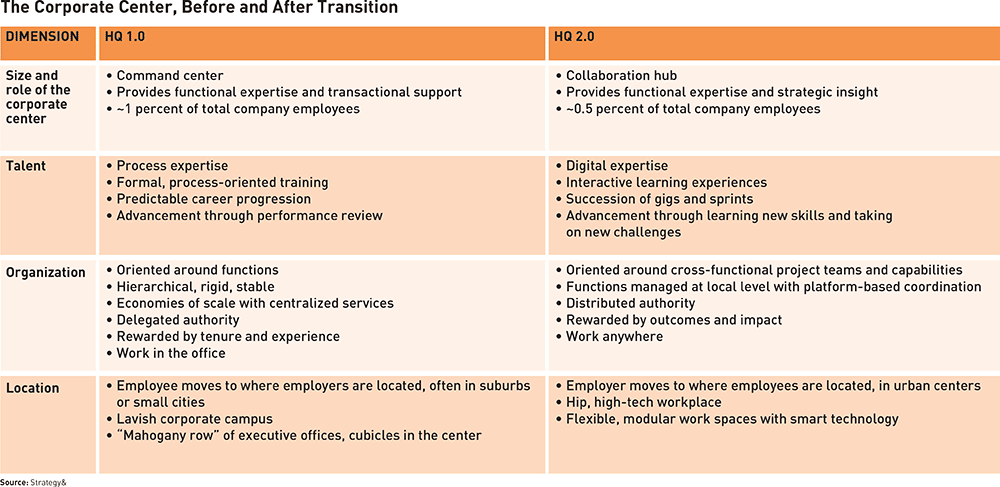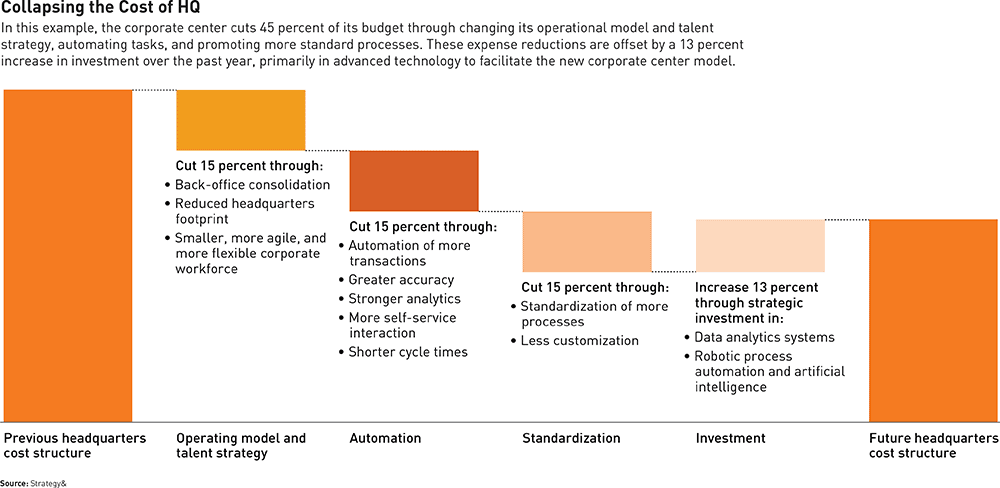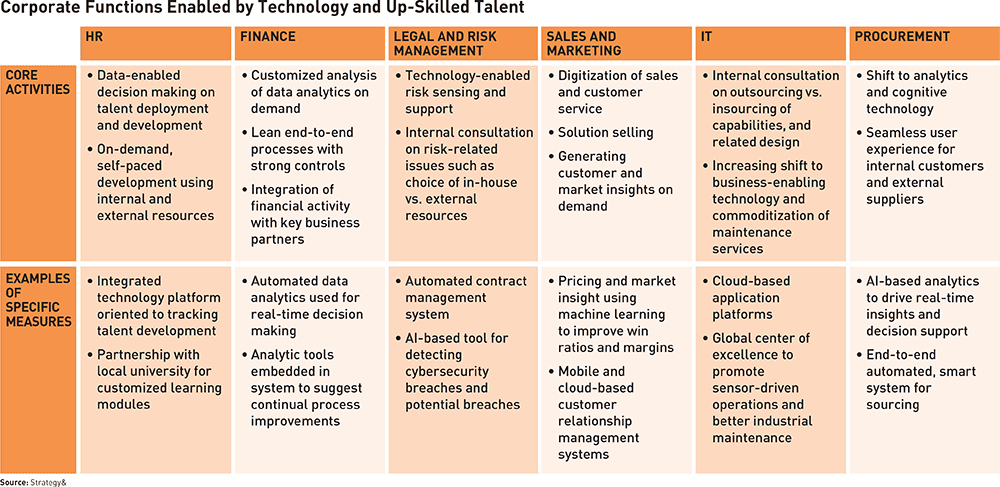HQ 2.0: The next-generation corporate center
Major companies are transforming their core and rethinking their functions.
Not so very long ago, corporate executives commuted to a gleaming headquarters building, often in a beautifully landscaped suburban campus. Greeted by attentive security guards and smiling receptionists, they walked down well-appointed hallways lined with mahogany paneling and expensive artwork to their offices on the executive floor. There, they reviewed petitions that had percolated up the ladder, and dispatched decisions to be executed by the army of troops on the front lines. After decades of hard work, these individuals had ascended to the top of their pyramid, overseeing the processes and practices that made the enterprise work, and enjoying all the perquisites and power of a C-suite functional officer in the corporate center of a major company.
Does this sound like executive headquarters at your company today? If so, then start to worry.
The corporate center in many companies is not what it used to be. It will change even more over the next five years. This change is not just a matter of the look and feel of the building. It concerns the size of headquarters (HQ), its location, its mix of talent, and its ways of working: everything to do with the role of leadership in your enterprise. As an executive or an aspiring functional leader, you have a once-in-a-lifetime opportunity — and frankly, an obligation — to rethink your function in order to better fit the needs of your business moving forward.
Winds of Change
In most companies, the corporate headquarters has always been the physical and emotional epicenter. A powerful C-suite has run the enterprise from this “bridge,” setting the corporate mission and values, developing the strategy, managing the business lines, and overseeing the overall performance and health of the company. In effect, the C-suite has mediated a continuous dialogue between two masters: the business units on one side and the board of directors on the other. Most of the members of this C-suite have been functional heads: CFO, CHRO, COO, CTO, chief strategy officer, general counsel, and so on.
Historically, these functional executives managed large staffs of in-house service providers — for example, accountants, HR administrators, and tech support. These services were centralized at corporate HQ and charged out to the business units as overhead. But as companies evolved and entered the 21st century, the transactional, “lights on” functional services (such as financial bookkeeping, HR administration, IT infrastructure, and basic procurement) were increasingly separated from the more distinctive, strategically important areas of expertise (such as financial planning and analysis, talent management, and IT architecture). The former were moved into shared services centers (SSCs), frequently in lower-cost locations. The latter remained part of the corporate center, often organized into centers of excellence. These developments improved the efficiency of the corporate center while providing expert services to its businesses, allowing it to hold sway — in both numbers and clout — over the business units in the field.
Now, however, relying on compliance, taking care of fundamental administration, and providing some expertise-driven services are no longer viable for C-suite members. That way of working is about to become extinct.
What prompts such a stark prognosis? A number of disruptive forces. Business units, facing more competition, are escalating their demands. They want more control over and higher value from the support they receive from HQ. Outsourcing is now easier and more diverse, operating across seamless platforms, providing a viable alternative to delivering administrative services to the HQ functions. Digital advances such as robotic process automation (RPA) and artificial intelligence (AI) are making possible new types of automated activity, eliminating a large portion of the work these HQ functions perform. And the millennial mind-set is increasingly influential, even for older generations: Members of the new generation want their work to be “meaningful” (according to their personal definition of meaning). They want simple, fast work processes, robust tools and technology, flexibility, and collaboration, and they want to be able to work anywhere.
In short, the economies of scale associated with centralized services have eroded. The functional security blankets justifying their expense no longer apply; it is not enough anymore to meet regulatory requirements and provide basic internal services. The business units and the new generation of talent are demanding more. Finally, the combination of new digital Industry 4.0–style platforms, robotics, intelligent machines, and advanced analytics are allowing companies to harness the explosion of data and fundamentally alter how and where work gets done.
The New HQ
Together, these trends force several dimensions of change in corporate headquarters (see “The Corporate Center, Before and After Transition”). The new corporate center will be smaller, but it will still have executive and functional leaders and their staffs, mostly limited to five ongoing roles. First, they will define and communicate the company vision, values, and identity. Second, they will develop the corporate strategy and be responsible for the necessary critical enterprise-wide capabilities. Third, they will oversee the business unit portfolio, and related legal, regulatory, and fiduciary activities. Fourth, they will allocate capital.
And fifth, the center will continue to provide centralized functional support, but with a smaller, more critical group of truly strategic services. Functions such as human resources, information technology, and finance will be far smaller, in both size and cost. Outsourcing, offshoring, and automation will strip away transactional work, leaving the corporate center with only the truly strategic work functional leaders have long aspired to deliver.
As headquarters-based shared service functions incorporate new digital tools, such as RPA, natural language processing, and cognitive computing, they become more productive and easily scalable. Thus, as the volume of transactional work shrinks, these traditional SSCs will either be upgraded to perform higher-value work or downsized. For those who see the trend and capitalize on it by becoming skilled in running the machines that would otherwise displace them, the future remains secure.
According to our estimates, the cost of the corporate center could shrink by 25 to 40 percent in the next five years as more work is outsourced and automated (see “Collapsing the Cost of HQ”). A high-value functional staff expert, working at headquarters, might cost U.S. companies between US$125,000 and $165,000 per year, including compensation, benefits, and employment taxes. A typical employee performing transactional work, at the same headquarters, might cost $60,000 to $80,000, including benefits. A similarly qualified offshore employee, working through an outsourcing contractor, would cost $15,000 to $30,000. A bot can perform the job for less than $15,000, and as the technology evolves, that figure will almost certainly decrease. Inevitably, companies will continue shifting activity to the less expensive alternatives of outsourcing and automation.
In this context, the added investment in IT (and in more sophisticated expertise, often on a contract basis) will be more than offset by other cost reductions that reduce staff and complexity. Some centralized staff members could be moved to local organizations or business units, where their costs will be easier to justify in terms of sales and customer-facing services.
A New Approach to Talent
These changes to the role of headquarters and its scope of work will create a major shift in the recruitment, development, and deployment of functional talent. The process expertise honed by HR, finance, marketing, and IT administrators will largely be automated. The most critical skills will be digital, analytical, and communications oriented. Instead of recruiting an army of basic functional talent, as in the old days, companies will increasingly look for “special forces”–style units of highly skilled functional expertise with a keen understanding of the business issues as well as relevant digital technologies. HQ functions will advertise for data scientists, digital engineers, and analytics experts.
The finance function, for example, might replace its staff of junior accountants — who process journal entries or produce management reports and substantiate spreadsheets — with a variety of specialized experts:
• Analytics and value managers, using data to inform decisions about pricing and value creation
• Business growth partners, acting as a bridge between finance and the business units
• Digital technical accountants, who can automate financial, tax, and reporting processes, converting them into algorithms, and making sure that the algorithms are correct
• Global process owners, managing the standardization and implementation of technological platforms and working with outside vendors
• Data scientists, developing and implementing simulations and models used to make decisions
• Digital engineers, developing new AI- and RPA-based solutions for business challenges
• Transformation leaders, managing cross-functional projects and overseeing organizational and cultural changes and the development of capabilities.
The cost of the corporate center could shrink by 25 to 40 percent in the next five years as more work is outsourced and automated.
Other functions will also shift their talent requirements. HR will look for digital talent professionals skilled in creating the tools that can manage real-time performance for people age 25 to 75. IT will shift its focus from mainframe and ERP systems to cloud-based and mobile apps. This will add to the demand for employees who know how to deploy those apps to engender higher-quality human–machine interaction and more engaging human experience.
Companies will compete on their ability to attract and retain these people, who often bring — along with their skills — lofty expectations for their companies. Thus, many companies are tailoring their talent value proposition to provide work that’s more meaningful, plus more learning and growth opportunities, more work–life balance and job flexibility, and more generally appealing employee experiences.
The new generation, most of whom have never known a world without a smartphone, expect the same convenient and speedy digital ways of working in their professional lives that they already have in their personal lives. Basic employee tasks — such as accessing a financial report, updating an HR profile, turning in expenses, or communicating with global colleagues — should be as easy and seamless as hailing a cab, ordering movie tickets, or FaceTiming with friends and family. Millennials are pushing companies not only to streamline clunky old-fashioned work processes, but to flatten the corporate hierarchy and speed up the information flow between the C-suite and the front line.
Corporate centers, which tend to be located in places with a relatively high cost of living and difficult commutes, will need to offer more flexible and diverse employment structures to attract people. These could include technology-enabled remote working options and nonstandard work schedules. Another possible lure would be on-demand sabbaticals supporting employees’ personal development via education, leisure, or time with family. For those who want to power forward in a career, offering a path with more rapid and merit-based progress cycles (40 percent of millennials expect a promotion every one to two years) will help companies attract and retain talent.
A Cross-Functional Structure
Goodbye, static org chart. Reporting structures and roles will no longer hold long enough to be fixed in a lines-and-boxes diagram. Although we don’t anticipate that corporate functions will fully disappear, the corporate center will no longer consist of a hierarchical organization of functional units, each managing a distinct set of deliverables. Instead, it will be defined by relationships and roles, with people often shifting to new assignments and reporting relationships. More relevant than where they fit will be tables describing what people do (see “Corporate Functions Enabled by Technology and Up-Skilled Talent”).
Though they will no longer have as large a staff or as broad a portfolio, functional leaders will now have a role they have long sought: providing strategically valuable expertise and perspective to the business units. To make this leap work, these leaders and their teams will have to emerge from their cocoons and work much more collaboratively with other functions and business leaders. Most work will be done through self-organizing cross-functional teams set up to address hot-button priority initiatives, while a small but stable backbone of processes that add core value operate in the background. Many teams will form and dissolve on a quarterly (or even weekly) basis, in a “sprint and scrum” fashion, to solve problems or score a quick win. Individuals may work across many teams over the course of a year, and some of those teams may not have a designated leader, instead leaving decision making to whoever has the relevant expertise for a specific problem.
A small, agile corporate center of this sort can be resilient, reliable, and relentlessly efficient, even when the company is global. It can capture the full value of functional collaboration and knowledge sharing, without an immense bureaucracy or overhead.
Location and Layout
It used to be that employees moved to accommodate their employers. Whether someone was fresh out of college or an ambitious middle manager, that person knew that the best jobs were located wherever the company’s headquarters might be. In deciding where to live, the worker followed the corporate center.
No longer. With intense competition, the nature of work at the corporate center is evolving to demand a higher-skilled workforce. Now, in deciding where to locate their headquarters, companies follow the talent. Amazon’s decision to locate its new headquarters in New York and near Washington, D.C., despite receiving sweeter financial incentives from competing locations, is one of many examples. The need to attract distinctive talent has provoked profound changes in the location and layout of corporate headquarters.
Inside the executive floor, there is no more mahogany row. No more oil portraits or quiet, closed-door offices. Companies now strive to provide open, flexible, and amenity-filled workplaces conducive to collaboration and free from hierarchical symbols. People sign up for space as they need it, rather than having it granted to them because of their position. “Me” spaces become “we” spaces flooded with natural light, like coffee bistros. Sustainability is front and center in both office design and facilities management. Rooms shift in size and shape to accommodate the immediate needs of self-organizing teams. Well-trained pets might come to work with their owners.
The goal of the modern corporate office is not to create a monument to the corporation, but to offer community to an increasingly dispersed workforce. Prospective employees don’t compare the company atmosphere to those of other large corporations, but to hire-as-you-go workplaces, which aren’t constrained by any assumptions about how a workplace should look or feel, and which continually innovate to become more appealing.
According to a recent report by Microsoft, four times as many employees now work outside the office than did just five years ago. With telecommuting so easy and affordable, and mobile technology so ubiquitous, many employees need a reason to come in to work. More and more, office design focuses on creating a sense of community and common culture, while offering companies significant real estate savings as the HQ footprint shrinks.
Shortly before its $26.2 billion purchase by Microsoft in 2016, LinkedIn put this approach into practice in a new 26-story skyscraper in San Francisco’s South of Market neighborhood. People who have worked in this San Francisco headquarters (one of three; the others are located in Sunnyvale and Mountain View, Calif.) say that only the CEO and CHRO have closed-door offices. The open-plan design includes tech-enabled conference rooms, artwork by local artists, brainstorm-encouraging activities (magnetic Mad Libs boards, Nerf-gun dart boards), designated quiet areas, and floor-to-ceiling whiteboard walls. There’s a pool hall, a fitness center with massage rooms, a music program with instruction in piano, guitar, and drums, and a roof patio with breathtaking views. Three varieties of kombucha are on tap, and breakfast, lunch, and even dinner, for those working late, are catered by the on-site full-service cafeteria.
Despite these amenities, remote collaboration is the norm. All conference rooms are equipped with easy-to-use videoconferencing, and employees all have a videoconferencing app on their laptops. This accommodates a great deal of flexibility in employee work schedules. Many LinkedIn employees rotate to a new role every 18 to 24 months.
Companies in more traditional industries are also rethinking their headquarters design. In 2016, Conagra, a giant food manufacturer with brands such as Healthy Choice, Hunt’s, Marie Callender’s, and Slim Jim, moved its HQ operations from Omaha, Neb., to Chicago. About 500 corporate center jobs are located in an open-plan office in Chicago’s Merchandise Mart. Every workstation is outfitted with a sit–stand desk, and the executive team sits with the rest of the employees in the middle of the open floor. “We’ve already been behaving in a way that is more entrepreneurial, more collaborative, and more innovative,” CEO Sean Connolly noted shortly after the move. “What the physical space does is help facilitate the culture we’re looking for.” (For more about Conagra’s shifting identity, see “The Four Building Blocks of Transformation,” by Al Kent, David Lancefield, and Kevin Reilly.)
Setting the Virtuous Circle in Motion
The new approach may seem daunting. Relocating or redesigning your corporate HQ is a momentous undertaking in itself. So is overhauling and up-skilling much of your functional talent base. Once the ball is set in motion, however, it gains momentum. As companies adopt a more agile way of working, they become magnets for millennial talent. Millennials, in turn, accelerate the adoption of digital technologies, which facilitates the consolidation of large SSCs, which reinforces more agile ways of working.
As with any self-reinforcing, snowballing system, the companies that move first gain advantage. You, as a corporate executive, don’t have to start with a full overhaul of headquarters; you can take steps within a function or a part of the business. Here are a few actions to start taking now:
• Objectively assess the state of your current corporate center, including how your business leaders view the current quality of functional support, the maturity and capabilities of your organization and team, and your ability to attract talent compared with that of competitors.
• Define what needs to change. What distinctive capabilities do you need to develop in your enterprise? Where are the talent pools you need to tap?
• Lay out three or four paths to meeting that future-state objective. Don’t chase functional excellence for its own sake. Instead, look for ways to gain momentum through a progression of successful moves. In each path, look for these forms of leverage: automating or digitizing current practices to gain scale. Reducing the amount of low-value work conducted at the corporate center (or at all). Shifting investment to the capabilities that distinguish your whole company. Allowing more decisions to be made on the periphery. Promoting informal shared mastery rather than formal oversight and control. Attracting, retaining, and developing the right talent.
For many top executives, the changes to corporate headquarters might seem bittersweet. They’ve arrived at a place in their career where they expected a lavish private office, a key to the executive washroom, and an administrative assistant dedicated to them. Instead, they have a desk in an open loft-like space, booked by the day, and a team of people continually shifting around them. But those who embrace the new HQ soon find they have few, if any, regrets. Your office may no longer have the ambiance of a country club lounge, but it will look and feel like an advantage.
Author profiles:
- Deniz Caglar is a leading practitioner in strategic cost transformation for Strategy&, PwC’s strategy consulting business. Based in Chicago, he is a principal with PwC US. He specializes in organization and cost transformations in financial services, retail, and consumer packaged goods. He is the coauthor, with Vinay Couto and John Plansky, of Fit for Growth: Strategic Cost Cutting, Restructuring, and Renewal (Wiley, 2017).
- Vinay Couto is a leading practitioner in strategic cost transformation for Strategy&. Based in Chicago, he is a principal with PwC US. He specializes in global operating model transformations in consumer packaged goods, industrial products, and financial services.
- Maureen Trantham is a specialist in organizational issues with Strategy&. She is a director with PwC US based in New York.






